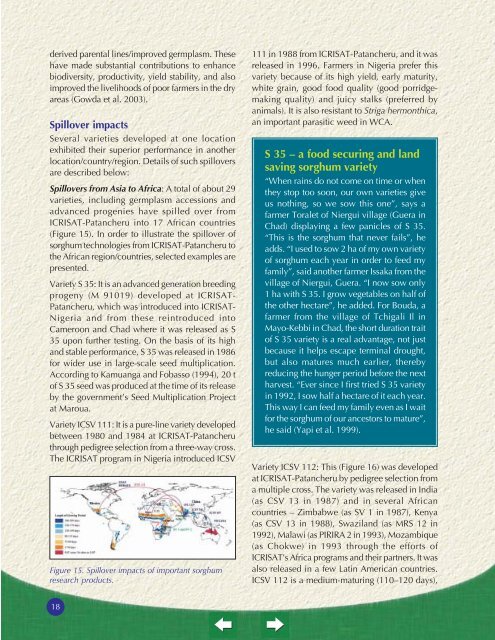Sorghum - icrisat
Sorghum - icrisat
Sorghum - icrisat
You also want an ePaper? Increase the reach of your titles
YUMPU automatically turns print PDFs into web optimized ePapers that Google loves.
derived parental lines/improved germplasm. These<br />
have made substantial contributions to enhance<br />
biodiversity, productivity, yield stability, and also<br />
improved the livelihoods of poor farmers in the dry<br />
areas (Gowda et al. 2003).<br />
Spillover impacts<br />
Several varieties developed at one location<br />
exhibited their superior performance in another<br />
location/country/region. Details of such spillovers<br />
are described below:<br />
Spillovers from Asia to Africa: A total of about 29<br />
varieties, including germplasm accessions and<br />
advanced progenies have spilled over from<br />
ICRISAT-Patancheru into 17 African countries<br />
(Figure 15). In order to illustrate the spillover of<br />
sorghum technologies from ICRISAT-Patancheru to<br />
the African region/countries, selected examples are<br />
presented.<br />
Variety S 35: It is an advanced generation breeding<br />
progeny (M 91019) developed at ICRISAT-<br />
Patancheru, which was introduced into ICRISAT-<br />
Nigeria and from these reintroduced into<br />
Cameroon and Chad where it was released as S<br />
35 upon further testing. On the basis of its high<br />
and stable performance, S 35 was released in 1986<br />
for wider use in large-scale seed multiplication.<br />
According to Kamuanga and Fobasso (1994), 20 t<br />
of S 35 seed was produced at the time of its release<br />
by the government’s Seed Multiplication Project<br />
at Maroua.<br />
Variety ICSV 111: It is a pure-line variety developed<br />
between 1980 and 1984 at ICRISAT-Patancheru<br />
through pedigree selection from a three-way cross.<br />
The ICRISAT program in Nigeria introduced ICSV<br />
Figure 15. Spillover impacts of important sorghum<br />
research products.<br />
111 in 1988 from ICRISAT-Patancheru, and it was<br />
released in 1996. Farmers in Nigeria prefer this<br />
variety because of its high yield, early maturity,<br />
white grain, good food quality (good porridgemaking<br />
quality) and juicy stalks (preferred by<br />
animals). It is also resistant to Striga hermonthica,<br />
an important parasitic weed in WCA.<br />
S 35 – a food securing and land<br />
saving sorghum variety<br />
“When rains do not come on time or when<br />
they stop too soon, our own varieties give<br />
us nothing, so we sow this one”, says a<br />
farmer Toralet of Niergui village (Guera in<br />
Chad) displaying a few panicles of S 35.<br />
“This is the sorghum that never fails”, he<br />
adds. “I used to sow 2 ha of my own variety<br />
of sorghum each year in order to feed my<br />
family”, said another farmer Issaka from the<br />
village of Niergui, Guera. “I now sow only<br />
1 ha with S 35. I grow vegetables on half of<br />
the other hectare”, he added. For Bouda, a<br />
farmer from the village of Tchigali Il in<br />
Mayo-Kebbi in Chad, the short duration trait<br />
of S 35 variety is a real advantage, not just<br />
because it helps escape terminal drought,<br />
but also matures much earlier, thereby<br />
reducing the hunger period before the next<br />
harvest. “Ever since I first tried S 35 variety<br />
in 1992, I sow half a hectare of it each year.<br />
This way I can feed my family even as I wait<br />
for the sorghum of our ancestors to mature”,<br />
he said (Yapi et al. 1999).<br />
Variety ICSV 112: This (Figure 16) was developed<br />
at ICRISAT-Patancheru by pedigree selection from<br />
a multiple cross. The variety was released in India<br />
(as CSV 13 in 1987) and in several African<br />
countries – Zimbabwe (as SV 1 in 1987), Kenya<br />
(as CSV 13 in 1988), Swaziland (as MRS 12 in<br />
1992), Malawi (as PIRIRA 2 in 1993), Mozambique<br />
(as Chokwe) in 1993 through the efforts of<br />
ICRISAT’s Africa programs and their partners. It was<br />
also released in a few Latin American countries.<br />
ICSV 112 is a medium-maturing (110–120 days),<br />
18
















